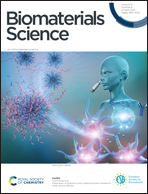A self-defense hierarchical antibacterial surface with inherent antifouling and bacteria-activated bactericidal properties for infection resistance†
Abstract
Biomedical device-associated infection (BAI) is one of the main reasons for the function failure of implants in clinical practice. Development of high-efficiency antibacterial materials is of great significance in reducing the incidence of BAI and prolonging the function of the implants as well as alleviate the suffering of patients. In this work, a hierarchical polymer brush modified surface that can self-adapt to bacterial stimuli for exhibiting synergistic antibacterial activities was constructed, and it consisted of upper poly(sulfobetaine methacrylate) (pSBMA) brushes and antimicrobial peptide (AMP) tethered bottom brushes. Under physiological pH conditions, the hydration layer formed by the upper pSBMA can not only effectively resist the initial adhesion of bacteria, but also mask the toxicity of the underlying AMPs and improve biocompatibility. Once bacteria colonized the surface, the release of MTL could be activated for timely bactericidal activity via bacteria-triggered local acidification, enabling efficient prevention of further development of bacterial infections. This self-defense hierarchical antibacterial surface with excellent and synergistic antibacterial functionalities shows great potential in infection resistance applications.



 Please wait while we load your content...
Please wait while we load your content...